
Industrial and manufacturing systems have long had huge impacts on the environment and society. The transition from traditional factories to smart factories has sparked the adoption of predictive maintenance as a means to address sustainable developement, in which the approach is used as a key role to improve availability, reliability and safety of used equipment.
Unplanned downtime: a real-life horror movie
Maintenance is never to be overlooked by manufacturers as unplanned downtime from faulty equipment results in lost production, disrupted operation, and high costs. On average, manufacturers lose US $22,000 for each minute of production line downtime [1]. Annually, a manufacturer can encounter 800 hours of equipment downtime a year [2], These numbers quickly add up to a massive sum of up to $647 billion in lost revenues - a year ! [3]
To avoid such scenarios, increasing operational efficiency is one of the drivers, and ensuring that all assets are at their peak performance - is a key to achieving this. Fortunately, the pace of technology has blessed the world with highly accurate sensors, high-speed communications, artificial intelligence, machine learning and advanced analytics. These advanced technologies combined have brought about a whole new idea above and beyond simply managing assets on a preventive-maintenance basis, but actually foresee potential failures and when maintenance is required for optimal performance. Predictive maintenance is closely related to this context. In recent years, manufacturers are turning to predictive maintenance to cut down unexpected failures of equipment, which improve their equipment uptime, saving time and money.
Predictive maintenance as a driver for operational efficiency
The term "predictive maintenance" is a step further from the predecessor preventive maintenance approach. Predictive maintenance refers to the application of data-driven, condition-monitoring techniques to track and detect various signs of deterioration, anomalies, and performance issues. Machines are equipped with sensors and systems that can continuously track and monitor the state of equipment during regular operation, then report it back in real-time. Based on the data gathered - such as sensor data from machines, historical maintenance records, and weather data , enterprises can leverage artificial intelligence to run predictive algorithms for making diagnoses. Precautions as to when a piece of equipment may fail will be entailed so that maintenance works can be scheduled before such events take place.
Maintenance managers can avoid doing unnecessary maintenance while also reducing unplanned equipment breakdowns by planning out maintenance work only when it is of absolute necessity. When properly executed, predictive maintenance reduces operational costs, avoids downtime problems, and enhances the overall performance span of an asset.
- Lower maintenance cost: By using dependable condition monitoring, the real expenses of maintenance activities can be reduced by more than 50% [4]. The comparison of maintenance costs takes into account actual labor expenses, maintenance office overhead, the hourly cost of production, any necessary tools or machinery, and any additional equipment needed to maintain the equipment.
- Reduced Hardware Failures: Routine inspections of the state of the gear and support structures can cut the amount of unexpected hardware failures by about 55% [5].
- Optimized use of spare parts: The capacity to anticipate the tools, labor skills, and defective and undersized components that need to be repaired ensures a reduction in both repair time and cost. The intralogistics expenses associated with spare parts can be reduced by more than 30% [6]. It will be less expensive to have a buffer stock of replacement parts available at the right moment rather than having to purchase all the spare parts for mechanical equipment, assets, and plants at once.
In addition to utilizing predictive maintenance, companies should also revisit their maintenance workflows to make sure these are as lean as they can reasonably get. Simply speaking, to eliminate any forms of redundancies, including waiting times, misplaced talents, unnecessary transportation, and unorganized MRO inventory.
A powerful solution for a long-term future
Even though the approach comes with very clear benefits, less than a quarter of machine operators are opting for predictive analytics due to its relatively high barrier for entry. A variety of smart technologies and sensors are used in predictive maintenance, which makes the installation and running highly complex. It requires a sizable upfront investment in buying and installing sensors and monitoring equipment, as well as the expertise necessary to develop, integrate, and run such systems and softwares. Additionally, employees must be able to operate new technology (sensors and other monitoring devices), which necessitates that the organization spend on staff training or hire qualified individuals. To avoid the above mentions, organizations should focus their efforts where it is needed, and on building tailor-fit solutions for their facilities. There is certainly no one-size-fits-all, so the key would be to deploy predictive maintenance on assets where it makes sense.
In the foreseeable future, predictive maintenance still offers a significant ROI in the long-term. In 2021, the market for predictive maintenance was estimated to be worth USD 4,2 billion, and by 2026, it is expected to witness a CAGR of 31.85%, reaching approximately USD 22,4 billion, making the approach a risk worth taking [7].































